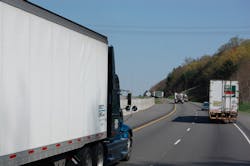Charting digitalization trends in freight transportation
Just a couple of years back the logistics industry was “purely driven by cost” in the words of Michael Lierow, a partner in the transportation practice within global consulting firm Oliver Wyman.
“Basically that was the only game that mattered,” he explained during a recent conference call hosted by Stifel Capital Markets.
No longer: “Today, at the end it is all about customer convenience, especially in the b-to-c [business-to-consumer] world,” Lierow, a 16-year consulting veteran focused on the postal and courier delivery markets. “No longer are we asking first about cost efficiency; rather, now we ask, is it improving convenience for the customer?”
Now, Lierow stressed that that taking cost out of the logistics system will still be done like before, but “customer convenience” will be driving it, not the other way around. “We will think about how to optimize after the ‘customer convenience’ is established,” he said.
The “digitalization” portion comes into play around the use of customer-specific data to find out what “convenience” means for that certain customer: geography, location, and the time of day they want to receive a parcel, he noted.
“It is also about using more data upstream on the supply chain to make delivery/fulfillment or to forecast when [customers] will make purchases,” Lierow explained.
“There is a whole world behind this use of data that digitalization entails; this is just the tip of the spear for things possible in the future,” he emphasized. “When you listen, there are no longer distinctions. Customer data links all of the elements in the supply chain. The question is not where is customer [located] to receive a parcel but when do they want to receive it and where do they want to receive it.”
How does this affect trucking? The delivery of trucking data for other logistics players to analyze will create “huge” change, Lierow thinks; all part of that “transparency need” for generating more data connections. “Connected data will need to be along the entire value chain,” he pointed out. “How much good data is there? And is it truly connected or is it sitting in 20 different databases?”
The next realm revolves around dynamic planning – not only as an enabler for greater customer convenience but as a requirement too.
“Especially in the context of higher volumes, when customers are using [smart phone] apps to re-route their bundles while in transit,” he said. “This will force a lot more re-planning a lot more often.”
Bill Rennicke, another partner in Oliver Wyman’s transportation practice, said on the call that about 85% of U.S. truckload movements are in random low density lanes. “So now you must think high density, high frequency, and high performance network of lanes,” he explained. “Service is now so important we may see more team operations because [shipment] reliability is much more important. Not to gain a lot of more miles per day but deal with things like traffic congestion. Also, the more integrated your data, the better rates you’ll get, the more volumes you’ll get.”
“Better visibility of where shipments are located means they can be re-routed or even canceled while in transit,” Lierow pointed out. “We will be moving from fixed storage points to flexible networks [with] algorithms automatically charting paths for goods through the network. That will increase value of convenience trucks can provide.”
About the Author
Sean Kilcarr
Editor in Chief
Sean Kilcarr is a former longtime FleetOwner senior editor who wrote for the publication from 2000 to 2018. He served as editor-in-chief from 2017 to 2018.


